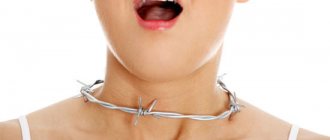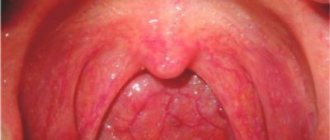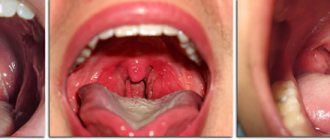Chronic tonsillitis is a process that is quite difficult to deal with, because often its signs are ignored or simply not noticed by patients, and doctors rarely pay due attention to it - until the patient himself begins to complain of feeling unwell. During exacerbations of the disease, a course of antibacterial agents is usually prescribed, and with a short “experience” of the disease, they help well. However, over time, the effectiveness of antibiotics decreases, and often those drugs that suppressed the growth of microbes during the first attacks cease to have any effect in the future. What explains this?
Is it possible to wash tonsils with an irrigator?
In this article
- Is it possible to wash tonsils with an irrigator?
- Why rinse your tonsils?
- Is it possible to rinse tonsils with an irrigator?
- Flushing the tonsils with an irrigator
- How to rinse tonsils at home with an irrigator
- When is tonsil flushing contraindicated?
- Basic recommendations: how to properly rinse tonsils at home
First, a few words about tonsils and tonsillitis. The human throat provides ideal conditions for the proliferation of fungi, viruses and bacteria. Tonsils (tonsils) protect the respiratory system from pathogenic microorganisms. They have microscopic lacunae into which food debris, dead epithelial cells and microbes fall. Tonsils are an important part of the body's immune system; they protect the lungs from infectious diseases, but at the same time become vulnerable to disease. A viral or bacterial inflammatory process in the lacunae of the tonsils causes chronic tonsillitis - a long-term inflammatory process of the pharyngeal or palatine tonsils.
This pathology can cause a person many problems, causing bad breath, fatigue, pain and sore throat. In addition, tonsillitis can cause tonsillitis and other complications. Treatment of this disease is carried out by an otolaryngologist. He prescribes a course of antibiotics and drugs for washing the tonsils.
Indications for rinsing
The accumulation of pus in the lacunae in acute or chronic tonsillitis is additionally accompanied by a deterioration in general health and the appearance of signs of intoxication. In acute cases, taking antibiotics, rinsing and bed rest helps, but in chronic cases, such treatment methods are ineffective. Often, rinsing is the only way to remove purulent exudate from lacunar folds. For chronic tonsillitis, otolaryngologists recommend sanitation of lacunae at least 2 times a year. Rinsing will allow you to prolong periods of remission and restore the functioning of the organ. Rinsing is also indicated for adenoids - a pathological enlargement of the pharyngeal tonsil. If conservative therapy is prescribed for adenoiditis, then lavage is included in the list of therapeutic methods.
Why rinse your tonsils?
Washing of the tonsils is carried out taking into account the characteristics of this organ. The tonsils are a collection of lymphoid tissue, inside of which there are small cavities and passages. They quickly fill with food debris, saliva and plaque from the teeth, which subsequently cause tonsillitis. Its manifestations can be minimized by washing the tonsils. You should contact an ENT specialist, who will prepare an antibacterial solution and carry out the procedure with a syringe or irrigator. Doing this yourself at home is dangerous, it can damage the tissue and cause complications.
The doctor may prescribe a course of physiotherapeutic procedures, the duration of which is 5-10 sessions - it all depends on the degree of the disease. When washing the tonsils, foreign substances and pus are removed from the lacunae. After several procedures, the process of self-cleaning of the tonsils begins. To avoid injury to the tonsils during tonsillitis, they can only be washed in the otolaryngologist’s office. Rinsing for the purpose of prevention is carried out at home using oral irrigators.
Are there any complications?
Despite the fact that washing the lacunar cavities is one of the most effective and safe techniques, sometimes patients experience adverse reactions. List of common complications:
- Tissue damage. Irritation and microtrauma of the epithelium cause painful sensations when swallowing. This happens when the procedure is performed by an inexperienced doctor or due to accidental movements of the patient.
- Allergic reactions. After washing out the purulent plugs, the cavities are treated with an antiseptic. If you have an allergy, there may be a local reaction: redness and swelling of the tonsils, or a general reaction, manifested by skin rashes and nasal congestion. If you are allergic to an antiseptic, replace the product.
- Spread of infection. During the leaching process, the contents of the lacunar cavities can get onto nearby mucous membranes and cause inflammation of the nasopharynx, pharynx or respiratory tract.
- Exacerbation of chronic diseases. The mechanism of the pathology is not fully understood, but it is assumed that an exacerbation is provoked by a local decrease in immune defense, when leukocytes are washed out of the lacunae along with pus. A person’s temperature rises, sometimes up to 40°C, weakness appears, and the lymph nodes become enlarged. In case of exacerbation, the course of therapeutic lavage is interrupted until the patient’s condition improves, and then the procedures are continued.
Most often, when washing the lacunar folds, microdamages occur in children and suspicious patients who, despite anesthesia, have difficulty sitting still. Other complications are relatively rare.
Is it possible to rinse tonsils with an irrigator?
An oral irrigator is a device that, by supplying pulsating water, cleanses the teeth and gums of food debris. According to dentists, regular use of such devices helps prevent the development of caries, gingivitis, periodontitis and other dental diseases. The irrigator should be used as an additional hygiene product, along with a toothbrush and floss. You need to use it at least 2-3 times a week, and better yet, every evening after traditional teeth brushing.
Modern irrigators are multifunctional devices that are suitable for cleansing the oral cavity, massaging the gums and rinsing the tonsils. The device reservoir should be filled with plain water or a disinfectant solution, furatsilin and other products approved by a doctor and compatible with a specific device. Let's learn how to wash your tonsils at home using an irrigator.
How effective is the device?
High results from using the device are built into the principle of its operation. Mechanical removal of germs, plaque and food particles using a water jet will allow you to efficiently clean many places that toothbrushes, orthodontic brushes and other dental cleaning devices cannot reach. In addition, the pressure in most devices can be adjusted, which significantly improves the quality of the procedure.
Flushing the tonsils with an irrigator
First you need to choose a suitable irrigator model. It can be portable or stationary, pulsed or microbubble. Portable models are not suitable for washing tonsils, as they have one significant drawback - the inability to smoothly switch the water supply mode. A sudden change in pressure and jet pressure can lead to tissue injury. Therefore, it is better to choose stationary models for washing the tonsils.
They are more functional and have several operating modes, including for cleaning gums and tonsils. In addition, stationary irrigators come with several nozzles, while portable ones are sold with one, or maximum two nozzles.
The minimum value of the cleaning jet pressure created by an irrigator suitable for washing tonsils should not be more than 150 kPa. Waterpik WP-108 E2 Ultra is ideal for this procedure - a stationary device that supplies pressure from 70 to 560 kPa. There is a lever on the handle for smooth switching of modes. You need to start the procedure with the weakest pressure, gradually increasing it. The device comes complete with 7 attachments. One of them is designed to clean gum pockets. It can also be used to wash the tonsils. Two standard attachments are also suitable for this.
Another suitable irrigator that can be used to wash tonsils is available under the brand name Aquapick AQ-300. It has several operating modes and 4 attachments included. The reservoir is quite large - 600 ml. It is enough for a complete cleaning for two or three family members. This device can be mounted on the bathroom wall using a bracket. It is not cheap, but it is one of the most functional. There is also a more budget option - B.Well WI-922. This device can be used to clear tonsils, but the minimum power it produces is 200 kPa. This irrigator is not suitable for children to wash their tonsils.
Our online store offers many stationary irrigators that can be used for washing tonsils. When purchasing, consider the following indicators: jet power, minimum pressure, number of operating modes, pulsation frequency and tank volume. Now we’ll find out how to rinse your tonsils with an irrigator at home.
What methods are used
The purpose of flushing is to remove the purulent exudate accumulated in the tonsils. This is done using liquid or vacuum. Methods used:
- With a syringe. Rinsing with a syringe is one of the simplest and most accessible ways to clean the cavities of the lacunae. The slight pressure of a stream of antiseptic liquid, created by pressing the piston, breaks the plugs and removes accumulations of pus. After washing the solution, the person spits it out.
- Vacuum. The Tonzillor-MM device is used. The vacuum method is more effective. The plugs are crushed by ultrasound and “sucked out” using a vacuum. Using the method allows you to achieve complete cleansing of the lacunae and ensure deep penetration of drugs into the tonsil tissue. The use of a vacuum allows you to avoid the spread of infection to nearby mucous membranes.
- Cavitation and ultrasound. The technique is based on the creation of a micro-shock wave. When passing through the treatment solution, ultrasound forms small bubbles that burst inside the lacuna, creating a shock wave. Washing is performed with the UZOL device. A new technique that is almost twice as effective as other methods, but not all clinics have the equipment.
Hardware flushing is performed under local anesthesia. When using a syringe, no anesthesia is required. But if a person experiences pain and discomfort, then the tonsils are irrigated with an anesthetic.
How to rinse tonsils at home with an irrigator
It is better to rinse the tonsils on an empty stomach in the morning, since a stream of water entering the larynx can cause vomiting. Such reflexes cease to bother you after regular procedures. The duration of rinsing the tonsils is 2-3 minutes, but you can start from 30-40 seconds until slight discomfort appears in the throat. Washing is performed according to the following algorithm:
- stand in front of the mirror and take the irrigator handle;
- set the jet pressure to the minimum level;
- insert the tip of the device into your mouth and turn on the device;
- When changing the position of the device, turn it off each time.
Before washing, make sure the device is in working order. Fill the reservoir with a suitable solution.
Do not use decoctions and infusions. The smallest plant particles included in them can become clogged in the device’s filter and damage it.
After the procedure, you need to thoroughly clean the nozzle and put it in the case. When washing, do not swallow the solution, as it contains microbes washed out of the lacunae of the glands. Do not tilt your head back to prevent liquid from entering your respiratory tract.
After the procedure, you may feel dry mouth and sore throat. This is a normal reaction of the body to the solution used and the pulsation of the liquid. Subsequently, the larynx will get used to the effects of pulsating water. However, if you experience a sore throat and blood in your saliva, stop using the irrigator and consult a doctor. At home, only preventive cleaning of the tonsils is possible. For tonsillitis, you need to undergo the procedure in the ENT office.
When is tonsil flushing contraindicated?
The procedure is not recommended for people with arterial hypertension - there is a risk of a sharp increase in blood pressure. Also among the contraindications:
- acute infectious diseases of the gums, teeth and throat;
- increased body temperature;
- retinal pathologies and glaucoma;
- severe heart failure;
- 1st and 3rd trimesters of pregnancy;
- allergy to solutions used for rinsing.
Do not use faulty appliances. An irrigator can damage your gums and tonsils if the jet pressure is too strong. If the device does not work well, replace it.
Diagnostics
THE INSTITUTE OF ALLERGOLOGY AND CLINICAL IMMUNOLOGY has a fundamental base that allows it to carry out the full range of diagnostic and therapeutic measures for any form of allergy that meets the level of international standards. Many of the diagnostic and treatment methods were developed by the staff of our Institute.
Diagnostic measures are based on anamnesis, clinical picture and laboratory diagnostics.
- Bacteriological examination of mucus from the tonsils and posterior pharyngeal wall for aerobic and facultative anaerobic microorganisms.
- Determination of the sensitivity of microorganisms to antibiotics and other drugs.
- Detailed general (clinical) blood test, clinical urine test.
- Determination of the concentration of C-reactive protein in blood serum.
- Determination of antistreptolysin-O in blood serum.
Basic recommendations: how to properly rinse tonsils at home
Experts advise adhering to the following rules when washing your tonsils:
- choose only high-quality irrigators with several operating modes and the ability to regulate pressure;
- wash your tonsils to prevent tonsillitis if it has already been diagnosed once;
- carry out the procedure in courses of 5-10 procedures with intervals of several months;
- during the period of preventive treatment, avoid spicy and hard foods (crackers, chips, etc.), which can burn or scratch the larynx;
- After rinsing, gargle with an antiseptic solution.
Advantages of treatment at an ENT center
Treatment of ear, nose and throat diseases at the ENT CENTER is a comprehensive and individual approach to each patient. By making a preliminary appointment on the medical center’s website or by phone, you can:
- get face-to-face consultation with a specialist;
- undergo treatment of ENT diseases using progressive techniques;
- receive recommendations for further conservative treatment and prevention of ENT diseases.
Contact the ENT CENTER : here they will help you solve any problem within the competence of ENT doctors as efficiently, safely, quickly and painlessly as possible.










